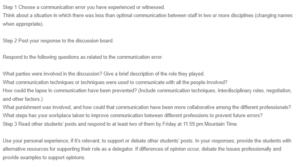Discussion – Professional Communication
Parties involved in the discussion
In this specific scenario, the parties involved were the primary care physician, surgical unit nurse, and physical therapist. The primary care physician was responsible for overall patient care and treatment decisions, while the surgical unit nurse was to manage the daily care of the patient in the hospital. The physical therapist was to develop and implement the physical therapy plan for the patient. The patient who was being treated had a complex medical condition. The communication lapse occurred when the physical therapist proposed a new exercise technique for the patient, but the information was not well communicated to the primary care physician, causing confusion and possible risks.
Communication technique used
The communication majorly occurred through written notes in the patient’s electronic health record and verbal updates during shift handovers. The communication lapse occurred when the recommendations by the physical therapist were not conveyed clearly to the primary care physician.
How to prevent the communication lapse
The communication lapse could have been prevented by having improved documentation in the electronic health record with clear instructions from the physical therapist. Also, regular interdisciplinary meetings to discuss and update the care plan for the patient will help in clearly stating the techniques required. Moreover, the use of standardized communication protocols to ensure critical information is not missed is very key (Sheehan et al., 2021).
Punishment and collaboration
There was no punishment involved in this case. However, the misunderstanding may have caused patient harm, and therefore, a collaborative approach to analyzing the root cause other than blaming would be most appropriate. Fostering open communication and a blame-free culture would encourage collaboration among professionals.
Improvements in Workplace Communication
One of the steps taken to improve workplace communication is the implementation of regular interdisciplinary training sessions to encourage communication skills. Also, a centralized communication platform was introduced for real-time updates on patient care. Lastly, the professionals are encouraged to ask for clarification when information is incomplete or unclear.
References
Sheehan, J., Laver, K., Bhopti, A., Rahja, M., Usherwood, T., Clemson, L., & Lannin, N. A. (2021). Methods and Effectiveness of Communication Between Hospital Allied Health and Primary Care Practitioners: A Systematic Narrative Review. Journal of Multidisciplinary Healthcare, Volume 14(14), 493–511. NCBI. https://doi.org/10.2147/jmdh.s295549
ORDER A PLAGIARISM-FREE PAPER HERE
We’ll write everything from scratch
Question
Step 1 Choose a communication error you have experienced or witnessed.
Think about a situation in which there was less than optimal communication between staff in two or more disciplines (changing names when appropriate).

Discussion – Professional Communication
Step 2 Post your response to the discussion board.
Respond to the following questions as related to the communication error:
What parties were involved in the discussion? Give a brief description of the role they played.
What communication techniques or techniques were used to communicate with all the people involved?
How could the lapse in communication have been prevented? (Include communication techniques, interdisciplinary roles, negotiation, and other factors.)
What punishment was involved, and how could that communication have been more collaborative among the different professionals?
What steps has your workplace taken to improve communication between different professions to prevent future errors?
Step 3 Read other students’ posts and respond to at least two of them by Friday at 11:59 pm Mountain Time.
Use your personal experience, if it’s relevant, to support or debate other students’ posts. In your responses, provide the students with alternative resources for supporting their role as a delegator. If differences of opinion occur, debate the issues professionally and provide examples to support opinions.

